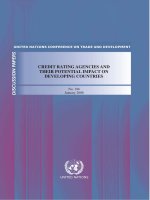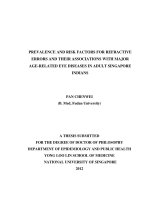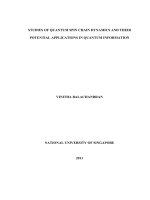Characterization of rhizobium isolates and their potential PGPR characteristics of different rhizosphere soils of Telangana region, India
Bạn đang xem bản rút gọn của tài liệu. Xem và tải ngay bản đầy đủ của tài liệu tại đây (253.06 KB, 6 trang )
Int.J.Curr.Microbiol.App.Sci (2017) 6(5): 2808-2813
International Journal of Current Microbiology and Applied Sciences
ISSN: 2319-7706 Volume 6 Number 5 (2017) pp. 2808-2813
Journal homepage:
Original Research Article
/>
Characterization of Rhizobium Isolates and their Potential PGPR
Characteristics of different Rhizosphere Soils of Telangana Region, India
K. Manasa*, R. Subhash Reddy, S. Triveni, B. Kranthi Kumar and N. Gowri Priya
Department of Agricultural Microbiology and Bioenergy, College of Agriculture, Professor
Jayashankar Telangana State Agricultural University, Rajendranagar, Hyderabad-500030, India
*Corresponding author:
ABSTRACT
Keywords
Rhizobium, PGPR,
Rhizospheric,
Heavy metals
Article Info
Accepted:
26 April 2017
Available Online:
10 May 2017
PGPR function in three different ways synthesizing particular compounds for the plants
facilitating the uptake of certain nutrients from the soil and lessening or preventing the
plants from diseases. Some of Plant growth promoting characteristics such as phosphate
solubilisation, Indole acetic acid (IAA) capacity, ability to produce ammonia (NH 3) as sole
nitrogen source, siderophore production and production of hydrogen cyanide were
evaluated in fifteen Rhizobacteria isolated from different rhizosphere soils of groundnut,
sunflower, maize, black gram, green gram, rice, soy bean and redgram. In this study, 47%
Rhizobial isolates showed phosphate solubilization.73% of the isolates showed IAA
production and 100% for ammonia, 53% for siderophores and 53% isolates showed for
HCN production. All the fifteen isolates were examined for the potential to inhibit two
fungal pathogens viz., Rhizoctonia solani and Sclerotium rolfsii under in vitro conditions.
Out of fifteen isolates, only 3 isolates exhibited inhibition potential against two soil borne
plant phytopathogen Among these isolates, RR-1 and GNR-1 were tolerant to all the heavy
metals (100 μg ml-1).
Introduction
Several environmental factors adversely
affect the plant growth and development and
final yield performance of a crop. Drought,
salinity, nutrient imbalances and extremes of
temperature
are
among
the
major
environmental constraints to crop productivity
worldwide. Soil pollution, is a very important
environmental problem and it has been
attracting considerable attention in recent
years (Garbisu, 2001; Marques, 2009).
Human activities, such as mining operations
and the discharge of industrial wastes, have
resulted in the accumulation of metals in the
environment. It has been reported that
microorganisms become adapted to these
environments by the acquisition of specific
resistance
systems
(Yilmaz,
2003).
Rhizobacteria have been classified into
beneficial, deleterious and neutral according
to their effect on host (Benizri, 2001).
Development of crop plants with stress
tolerance is a very important research.
Recently, the scientists try to improve plant
tolerance
to
extreme
environmental
conditions
through
the
biofertilizers
treatments (symbiotic nitrogen fixing bacteria,
asymbiotic nitrogen fixing bacteria and
mycorrhiza). Rhizobium population tolerate to
major environmental factors than their host
legumes.
Rhizobium
symbiosis
with
2808
Int.J.Curr.Microbiol.App.Sci (2017) 6(5): 2808-2813
leguminous plants and fix atmospheric N2.
Rhizobium spp. are gram-negative soil
bacteria that have a profound scientific and
agronomic significance due to their ability to
establish nitrogen-fixing symbiosis with
leguminous plants, which is of major
importance to the maintenance of soil fertility
(Somasegaran, 1994). For this reason and
taking into consideration the importance of
legumes in animal and human consumption,
some attention has been given to the effects
that heavy metals exert on Rhizobium isolates
as free-living organisms or symbiotically
associated with legumes (Ibekwe, 2010).
Materials and Methods
oxidase test, catalase test, H2S production and
starch hydrolysis as per the standard methods.
In vitro screening of multiple plant growth
promoting activities of Rhizobium spp.
Production of indole acetic acid
Bacterial cultures were grown for Rhizobium
on their respective media at 36±2 °C. Fully
grown cultures were centrifuged at 3000 rpm
for 30 min. The supernatant (2 ml) was mixed
with two drops of orthophosphoric acid and 4
ml of the Salkowski reagent (50 ml, 35% of
perchloric acid, 1 ml 0.5 M FeCl3 solution).
Development of pink colour indicates IAA
production.
Collection of Sample
Production of HCN
Eight different rhizospheric soil samples were
collected from Groundnut, Sunflower, Maize,
Black gram, Green gram, Rice, Soy bean and
Redgramfield
grown
in
PJTSAU
Rajendranagar, Hyderabad. The sample was
collected in 1cm depth and it was packed in a
sterile polythene bag and labelled properly.
Isolation of Rhizobium Isolates
The isolation of Rhizobium spp. from soil
samples, 1g of soil sample was serially
diluted in sterile distilled water, 0.1 ml of soil
suspension from 10-1 to 10-6 was spreaded
on yeast extract mannitol agar (Collavino,
2010).
All the isolates were screened for the
production of hydrogen cyanide by adapting
the method briefly, nutrient broth was
amended with 4.4 g glycine/l and bacteria
were streaked on modified agar plate. A
Whatman filter paper no. 1 soaked in 2%
sodium carbonate in 0.5% picric acid solution
was placed at the top of the plate. Plates were
sealed with parafilm and incubated at 36±2 °C
for 4 days. Development of orange to red
colour indicated HCN production. Bacterial
cultures were grown in a nutrient agar
medium for 18-24 h at 36±2 °C. The cultures
were mixed with appropriate amount of H2O2
on a glass slide to observe the evolution of
oxygen
Identification of Rhizobium spp
Ammonia production
The bacterial isolates were identified by using
cultural, morphological and biochemical
characteristics features described in Bergey’s
manual of determinative bacteriology and
stored at 4°C on slants and maintained
through sub-culturing. The isolates were
characterized by Gram staining, motility test,
Methyl Red, Voges Proskauer, Citrate,
The isolates were tested for ammonia
production by inoculating the isolates in to 10
ml of pre-sterilized peptone water in the test
tubes. The tubes were incubated for 48-72h
at36±20C. Nessler’s reagent (0.5 ml) was
added in each tube. Change in colour of the
2809
Int.J.Curr.Microbiol.App.Sci (2017) 6(5): 2808-2813
medium from brown to yellow colour was
taken as positive test for ammonia production.
Phosphate solubilization
Bacterial isolates were evaluated from the
ability to solubilize inorganic phosphate.
Pikovskaya’s agar medium (HiMedia,
Mumbai) containing calcium phosphate as the
inorganic form of phosphate was used in this
assay. A loopful of bacterial culture were
placed on the plates and kept for incubation at
28°C for 7 days. The presence of clear zone
around the isolate indicate positive for the
test.
respective temperature and time. Loop ful of
each bacterial isolate was streaked on the
potato dextrose agar plate at one end, which
was pre-inoculated with 5 days old, 5mm
mycelial disc of test pathogen at the other
end. Control plate was maintained by placing
only pathogen mycelial disc in the centre
without bacteria.
The assay plates were incubated at 28 10C
for 5 days and observations were made on
inhibition of mycelial growth of the test
pathogens. For each bacterial isolate three
replications were maintained with suitable
controls.
Siderophore production
Results and Discussion
Siderophore production was estimated
qualitatively. Chrome Azurol S (CAS) Agar
medium (Schwyn and Neilands, 1987): For
the detection of siderophores, each
Pseudomonas isolate was grown in synthetic
medium, containing 0.5 µM of iron and
incubated for 24 h on a rotary shaker at room
temperature. Chrome Azurol S (CAS) assay is
used to detect the siderophores. The CAS
plates were used to check the culture
supernatant for the presence of siderophores.
Culture supernatant was added to the wells
made on the CAS agar plates and incubated at
room temperature for 24 h. Formation of
yellow to orange coloured zone around the
well indicates siderophore production.
Screening of pure isolates for PGPR
properties
Antagonistic activity
For identification of efficient PGPR strains
with multiple activities, microbial isolates
(Rhizobium and Pseudomonas fluorescence)
were subjected to further studies to understand
their Plant Growth Promoting Properties
(PGPR) under in vitro conditions.
Pure isolates of common disease causing soil
phytopathogens viz, Rhizoctonia solani,
Sclerotium rolfsii were obtained from the
Dept. of Plant Pathology, College of
Agriculture, Rajendranagar. Antagonistic
activity was verified by following dual culture
technique (Skidmore and Dickinson, 1976).
First, the bacterial isolates were streaked on
respective media plates and incubated at
Plant root colonizing bacteria can function as
harmful, deleterious rhizobacteria (DRB) or
beneficial,
plant
growth
promoting
rhizobacteria (PGPR). PGPR colonize roots of
monocots and dicots, and enhance plant
growth by direct and indirect mechanisms.
Modification of root system architecture by
PGPR implicates the production of
phytohormones and other signals that lead,
mostly to enhanced lateral root branching and
development of root hairs. PGPR also modify
root functioning, improve plant nutrition and
influence the physiology of the whole plant.
IAA production
Out of fifteen Rhizobial isolates 11 were able
to produce IAA. Further, out of 15 isolates
2810
Int.J.Curr.Microbiol.App.Sci (2017) 6(5): 2808-2813
GNR-1(24.12 µg ml-1) showed maximum
IAA, followed by SFR-1(15.20 µg ml-1),
GGR-2(14.24 µg ml-1), MR-1 (13.24 µg ml-1),
GGR-1(12.24 µg ml-1), RGR-1 (12.22 µg ml1
), RR-1(12.14 µg ml-1), GNR-2 (11.41 µg ml1
), SFR-2(11.34 µg ml-1), MR-2 (11.25 µg ml1
),RR-2 (9.14 µg ml-1)
Collavino (2010) reported that phosphatesolubilizing bacteria native to acid soilhad
ability to promote Phaseolus vulgaris growth.
The study is conducted to characterize three
bacterial strains in solubilising rock
phosphates as well as their impact in
promoting soybean growth under pot grown
conditions
Out of 15 Rhizobium isolates 15 were able to
produce ammonia. Further, out of 15 isolates
RR-1 exhibited strong
(+++) Ammonia
production and
MR-1,MR-2,MR-3,BGR1,GNR-1,GNR-2,GGR-1,SFR-1,SFR-2, RGR1 and SYR-1 produced moderately (++).
Whereas the remaining 3 isolates viz, RR-2,
BGR-1, MR-4 and GGR-2 were scored as
weak (+) for Ammonia production
Phosphate solubilization
HCN Production
Out of 15 Rhizobium isolates, 8 produced
HCN. Further, out of 8 isolates RR-1
exhibited strong (+++) HCN production and
GNR-1 scored as moderate (++) for HCN
production. Whereas the remaining 6 isolates
viz, MR-2, BGR-1, GNR-2, GGR-2, SFR-2,
SYR-1 foundto be weak (+)in HCN
production
Among 15 Rhizobial isolates 7 isolates were
able to solubilize phosphate on pikovskaya’s
media containing Tri calcium phosphate in the
range of 10mm to 25mm. Among 7 Rhizobial
isolates SFR-2 recorded the highest
solubilization zone (22.00mm) (Plate.4.3(a))
followed by RR-1 & MR-1 (19 mm), GNR-2
(18.00 mm), RR-2 (14.00mm) and less
solubilization by GNR-1,SYR-1(10.00mm).
Siderophore production
Ammonia production
2811
Int.J.Curr.Microbiol.App.Sci (2017) 6(5): 2808-2813
Out of 15 Rhizobium isolates 8 were able to
produce siderophores. Further, out of 8
isolates RR-1 exhibited strong (+++)
Siderophore production and GNR-1 and SYR1 produced moderately (++). Whereas the
remaining 5 isolates viz, RR-2, BGR-1,GNR2,GGR-1 and SFR-2 were scored as weak (+)
for Siderophore production.
Rhizobium
with
Rhizoctonia
Rhizobium with Sclerotium rolfsii
Arora et al, (2001) stated that siderophore
producton by Rhizobial strains has been
considered as a potential way to improve
nodulation and N2 fixation in iron deficiency
conditions. The beneficial effect of using
siderophore producing strains
of
Bradyrhizobium
sp.
and
Rhizobium
melilotimight favour the persistence of
Rhizobia in iron deficient soils.
Antagonistic activity of Rhizobium isolates
Out of 15 Rhizobium isolates 4 isolates
showed
inhibition
potential
against
Rhizoctonia solani, viz. RR-1 (36.60%),
GNR-1 (36.05%), SFR-2 (36.60%) and SYR-1
(36.60%). The maximum per cent inhibition
against Rhizoctonia solani was showed by
SYR-1 (36.66%) with inhibition zone 4 mm
Four out of 15 isolates were inhibitory to
Sclerotium rolfsii, viz. RR-1 (36. 05%), GNR1 (37.50%), GNR-2 (36.60%) and SFR-2
(31.10%)The maximum per cent inhibition
against Sclerotium rolfsii, was showed by
GNR -1 (37.50%) with inhibition zone 3 mm
solani,
Out of 15 Rhizobium isolates 3 isolates viz,
RR-1, GNR-1and SFR-2 showed inhibition
potential against both Rhizoctonia solani and
Sclerotium rolfsii, the isolate that showed
maximum
inhibition
potential
against
Rhizoctoniasolani was also inhibitory to
Sclerotium rolfsii to a lesser extent based on
per cent inhibition and vice versa. Hence it
can be inferred that the Rhizobium isolates
RR-1, GNR-1and SFR-2 could be considered
for their bio control activity.
References
E. Benizri, E. Baudoin, A. Guckert, Root
colonization by inoculated plantgrowthpromoting rhizobacteria. Biocon. Sci.
Tech. 11 (2001) 557-574.
Collavino, M.M P.A. Sansberro, L.A.
Mroginski, O.M. Aguilar 2010.
Comparison of in vitro solubilization
activity
of
diverse
phosphatesolubilizing bacteria native to acid
soiland their ability to promote
Phaseolus vulgaris growth. Biology
Fertility of Soils. 46:727–738.
Garbisu, C., Alkorta, I Phytoextraction: a cost
effective plant based technology for the
removal
of
metals
from
the
environments.
Biores.
Technol.77
(2001) 229–236.
A.M. Ibekwe, J.S. Angle, R. L. Chaney, P.
Van berkum, Sewage sludge and heavy
2812
Int.J.Curr.Microbiol.App.Sci (2017) 6(5): 2808-2813
metal effects on nodulation and nitrogen
fixation of legumes. J. Environ. Qual.
24 (1995)1199– 1204.
Marques, A. P. G. C.,H. Moreira, A. O. S. S.
Rangel, P. M. L. Castro, Arsenic, lead
and nickel accumulation in Rubus
ulmifolius growing in contaminated soil
in Portugal. Journal of Hazardous
Materials. 165 ( 2009) 174–179.
Skidmore, A.M and Dickinson, C.H. 1976.
Colony
interaction
and
hyphal
interference between Septorianodorum
and phylloplane fungi. Transactions and
Journal of the British Ceramic Society.
66: 57-74
Collavino, M.M P.A. Sansberro, L.A.
Mroginski, O.M. Aguilar 2010.
Comparison of in vitro solubilization
activity
of
diverse
phosphatesolubilizing bacteria native to acid
soiland their ability to promote
Phaseolus vulgaris growth. Biology
Fertility of Soils. 46:727–738.
Schwyn, B. and Neilands, J.B. 1987.
Universal chemical assay for the
detection
and
determination
of
siderophores.
Analytical
Biochemistry.160: 47–56.
P. Somasegaran, H.J. Hoben, Handbook for
Rhizobia, Springer-Vera, Berlin, 1994.
E.I. Yilmaz, Metal Tolerance and Biosorption
Capacity of Bacillus circulans Strain
EB1. Research in Microbiology. 154
(2003) 409–415.
How to cite this article:
Manasa, K., R. Subhash Reddy, S. Triveni, B. Kranthi Kumar and Gowri Priya, N. 2017.
Characterization of Rhizobium Isolates and their Potential PGPR Characteristics of different
Rhizosphere Soils of Telangana Region. Int.J.Curr.Microbiol.App.Sci. 6(5): 2808-2813.
doi: />
2813









